Graph Neural Networks for Intelligent Modelling in Network Management and Orchestration: A Survey on Communications
Abstract
1. Introduction
- The relations between (variant) GNNs and communication networks are presented by discussing the specificity of input network topologies and device/resource abstraction. The possible input features, processing flows, and target applications (e.g., congestion prediction, rule configuration) in the network management and orchestration entities are specified for collaborating with GNN execution.
- We categorize GNN-based modelling domains into 4 sub-section, namely (1) task offloading, (2) routing optimization, (3) VNF orchestration, and (4) resource allocation, which are essential core policy controls in SDN/NFV-enabled and other wired/wireless networks. In each sub-section, we emphasize the GNN-enabled system architectures, system models, working flows, algorithm designs, simulation environment, and the key performance metrics for evaluation. We prioritize the summaries on enabler technologies, observable GNN components in networking, and other complementing methods (e.g., reinforcement learning and encoder-decoder).
- We highlight the characteristics of several application deployments using GNN-empowered mechanisms in communication perspectives. The selected applications include autonomous control in optical networks, Internet of Healthcare Things, Internet of Vehicles, Industrial IoT, and other smart city services.
- We identify the challenging research problems and future directions. To the best of our knowledge, we suggest several improving and extending features in GNN-based approaches for next-generation autonomous network modelling.
2. Preliminary Studies on GNN
2.1. GNN Architectures
2.2. GNN Variants
3. Relations between GNN and Communication Networks
4. GNN for Intelligent Modelling in Network Management and Orchestration
4.1. Offloading Strategies
4.1.1. Dependent Task Awareness
- State space: (1) EC embedding consists of edge server and user statuses, which later feed into MLP for learning the embedding process. (2) Task embedding considers the multi-task dependencies using the GCN-based approach.
- Action space: Discrete indices, denoted as , for representing the decisions of offloading destination, where 0 indicates the local computation and 1 to indicates the edge server index.
- Reward–evaluation metrics: The difference between the summation of current-state and next-state (in terms of energy-time cost of all users).
- The actor–critic framework: (1) Actor network for action sampling and selection. (2) Critic network for evaluating the efficiency of the sampled/selected action; furthermore, GCN was applied to extract/generalize the structures of directed acyclic graphs from the application.
4.1.2. Continuous Task Awareness
- State space: The observations on servers and tasks were used as states. A Euclidean space of the original task attributes was extracted and transformed into directed acyclic graphs.
- Action space: The probability distribution in offloading scheduler was indicated as an action to decide the offloading certainty between tasks to any particular servers. The action selection follows the output of actor networks. To optimize the function approximation, network parameters are exchanged between training and target.
- Reward–evaluation metrics: The determination of negative scores defined the efficiency of the selected action, which was configured as an offloading scheduler to assign the task-server pair and result in a total waiting time.
4.2. Routing Optimization
4.2.1. Congestion Awareness
- Deploying network controller to activate elastic or programmable networking,
- Modelling architecture for congestion-aware features, and
- Using models to estimate and alleviate the high possibility of congestion statuses.
4.2.2. Delay Awareness and Link-Level Realization
- The reward returns 50 if the link destination and packet destination are identical.
- The reward returns 20 if the link source is attached to the current node.
- Otherwise, the reward returns −20.
- Networking environment setup for DRL engine: Network topology’s state observations of link capacity and connectivity.
- Action space: Link-level bandwidth allocation.
- GNN architecture: processing on all links to optimally find the link relation entity and compute message passing.
- Agent execution: (1) Interactions with the environment state, (2) action orchestration on three-tuple (source, destination, bandwidth), and (3) valuation on state-action pairs for prioritizing the optimal policy based on explored/exploited-driven procedures [62].
- Loss and accuracy of model training and validation.
- Time overhead in path delay information.
- Number of flowlets.
- End-to-end delays to determine (1) the performance specifications on parallel forwarding in multi-path transmission, (2) delay minimization on how well the path is prioritized, and (3) how efficient the idle timeout setting can signify.
- Flow completion time including total duration and reordering.
- Throughput in different congestion states and strengths which were configured by the number of flows between 1000, 5000, and 10,000.
4.2.3. QoS Realization
- The average packet drop ratio was set to less than 0.1%,
- The average jitter was set to less than 20% of the average delay.
- The average delay was aimed at minimal contingency.
- The complexity of traffic models (on-off periods, autocorrelated exponentials, and modulated exponentials).
- Queuing configurations (scheduling policies).
- Real-word topologies from NSFNET and GEANT.
- Initialization: Directed graph of nodes and edges (information of weight between links, bandwidth, and traffic patterns).
- Feature extraction: The variables on each node and edge become fixed-dimensional vectors and the implementation of GNN executes to get the feature values; after all, the output vectors remain in the same dimension.
- Output: The routing table with an indication of the current node, destination node, and the number of edges (neighboring to the current node).
4.2.4. Output-Port Prediction
- Generation of node features using GNN.
- Generalization of IP information to feature space (graph-structured data for GNN) using artificial neural networks.
- Attention mechanisms implementation for the bounded convex region from generalized features (GNN) and projected IP.
- Artificial neural networks for prediction model of the output port.
4.3. VNF Orchestration
4.3.1. Energy Awareness
- State space: SFC graph of VNFs information, including (1) required computational resources, (2) allocation statuses of VNF in the particular physical server, (3) availability ratio of computational resources in the particular server, (4) required bandwidth capacities, and (5) deployment statuses of VNF. The variables on virtual links and VNF deployment were initialized through state sampling functions.
- Action space: Index of the server to deploy the running VNF in a particular timeslot.
- Reward–evaluation metrics: variables to indicate the starting status of a new server after applying the selected action.
4.3.2. QoS Awareness
- State space: Inputs of the decoder (node encoding, VNF updates, etc.), annotation, and adjacency matrix, which feed into the graph-recurrent neural networks.
- Action space: Neighboring node selection and processing statuses of VNF at the current selected node.
- Reward–evaluation metrics: Total delays of the SFC path execution, as a scoring metric with the weight of penalty.
4.3.3. Resource Awareness
- Monitoring (flow manager) states of physical servers, virtual nodes, and links for feeding into the extraction/generalization phase.
- Graph-structured input that gathered for the initialization phase to the message-passing execution.
- Executing the model for outputting optimal path with efficient delay and resource.
- The output translation for executing as a (predictive) action to configure VNF placement, virtual machine placement, and path configuration in the orchestrator.
- The input attributes was used to gather the network states for interacting between the data plane and GNN-based processing in the DRL framework.
- The policy translator executed the VNF deployment to the data plane following the action of the DRL agent, which was processed through a GNN-based mechanism.
4.3.4. Cost Awareness
4.3.5. Link Loading Awareness
4.4. Resource Allocation
- A topology of 2 access-points (AP), 8 end-users (EU), and radio link interferences.
- Graph generation procedure by replicating each node/link into an entire graph .
- Input network topology as a graph to the GNN mechanism.
- Execution of delay/resource-aware metrics for optimizing resource allocation.
- Configuration of GNN readout to resource management policies.
5. Application Deployment
5.1. Autonomous Control in Optical Network
- Data plane: Optical line terminal in access and other entities in metro and core.
- Control plane: Modified SDN controller with (1) OpenFlow-enabled modules, (2) reconfigurable add-drop multiplexers, (3) network configuration protocol, (4) interfaces to the routing system, and (5) path computation element protocol.
- Application plane: Services of optical signal-to-noise ratio track, routing policy, troubleshooting, optical amplifier management, etc.
5.2. Internet of Healthcare Things
- Contract layer: Secure data storage and sharing processing scheme.
- Incentive layer: Issuing and distribution mechanisms.
- Consensus layer: Delegated proof-of-stake as the consensus protocol.
- Network layer: Kademilia implementation (distributed Hashtable), communication, and verification mechanisms.
- Data layer: Merkle patricia tree, hash chain, timestamp, symmetric/asymmetric encryption, and digital signature.
5.3. Internet of Vehicles
5.4. Industrial IoT
5.5. Smart City
6. Research Challenges and Future Directions
- Multi-Aspect Awareness: The existing GNN-based modelling mostly considers the awareness of a single objective, which leads the proposed mechanism to be biased by following only the proposed system architecture. With non-flexibility and non-scalability, the applicability of GNN-based in real-world deployment will be deficient. In the coarse-grained aspect, the overall processing flows should be investigated, and multi-aspect (multi-objective) awareness [98,99] of the joint weighted sum of QoS, energy, resource, and others is highly suggested to consider in further investigation.
- Expansions of Federated GNNs: based on several surveyed studies, the network states (e.g., topology, traffic flows, routing configuration, and forwarding paths) are collectively uploaded via the central controller/processing modules for feeding the GNN model without considering the possibility of privacy-restricted information. Following the general data protection regulation (GDPR) obligations, the collectible data for processing DL-based applications require user consent and legit authorization. Therefore, (edge) federated learning [100,101] is introduced and offers collaborative model construction between local devices, (edge) aggregators, and global parameter servers. Instead of transmitting raw data, (edge) federated learning allows the model round communications between selected participants and the server. The participants can receive the initialized global model (e.g., model structures, hyperparameters, and target applications) to execute with its local data batch. The local participants optimize the loss and model parameters iteratively, then offload to the global server for averaging and aggregating until the final learning model is constructed with satisfying accuracy metrics. With motivations and influence factors of the federated learning framework, the study on federated learning and GNN has been converged and termed Federated GNNs (FedGNNs) [102,103]. The challenges and opportunities in this method can be (1) the adaptivity improvement of FedGNNs against the security threads, (2) multi-type graph data handling, (3) aggregation accuracy, and (4) communication-efficient extraction. The expansions of FedGNNs in policy optimization, such as routing strategies, offloading decisions, resource allocation, and VNF orchestration, are highly crucial and applicable to the privacy-preserving aspect of future intelligent network service management systems.
- Autonomous Convergence of DRL and GNN: several studies converge the formulation of reinforcement learning problems, use the components of MDP, and apply DRL agents with GNN-based approaches. The utilization of GNN can be used to (1) provide the state representative to the DRL agent or (2) act as an actor, critic, online, or target networks in DRL agent via a multi-platform execution. By converging two different algorithms through multiple entities and interfaces, the performance could be inadequate and unreliable. Therefore, the consideration of autonomous convergence between DRL and GNN is highly recommended to be explored.
- Communication-Efficient GNN: for large-scale graph data, the total execution time of the GNN-included system remains a challenging issue and requires a comprehensive modification (whether to cluster the graph data efficiently or offer an adaptive divergence scheme to execute the GNN modelling). GraphSAGE can be sufficient for inductive graph inputs and construct node embeddings efficiently from unseen large-scale topologies [32]. The optimization of communication overhead has to consider critically when executing GNN-based approaches, particularly in high-congested network states with mission-critical service operations. The central controller/orchestrator has to translate the output policy (action) from the GNN approach in a real-time manner with pre-estimated configuration and modification times, which necessitates prioritizing the deployment of a communication-efficient GNN.
- Explainable/Justifiable GNN: XAI aims to tackle network automation, intelligent radio/edge networks, resource management, privacy, and security enhancement for next-generation communications [107,108]. With GNN-empowered architecture, the high-level information of graph-structured cell-level, node-level, user-level, and service-level information can be possible for extraction to feed the model mechanism. By bridging mutual understanding between explainable GNN and stakeholders (e.g., legal auditors, service providers, end-users), the logical interpretation is linked to enhance trustworthiness. The level agreement and justification modules can be set as a priority policy before configuring any management and orchestration rules. Figure 8 presents the GNN-empower network architecture for enhancing the XAI in 5G/6G technical aspects.
7. Conclusions
Author Contributions
Funding
Data Availability Statement
Conflicts of Interest
References
- Abbasi, M.; Shahraki, A.; Taherkordi, A. Deep Learning for Network Traffic Monitoring and Analysis (NTMA): A Survey. Comput. Commun. 2021, 170, 19–41. [Google Scholar] [CrossRef]
- Xie, X.; Dou, Z.; Zhang, Y. Reinforcement Learning-Based Intelligent Decision-Making for Communication Parameters. KSII Trans. Internet Inf. Syst. 2022, 16, 2942–2960. [Google Scholar]
- Salh, A.; Audah, L.; Shah, N.S.M.; Alhammadi, A.; Abdullah, Q.; Kim, Y.H.; Al-Gailani, S.A.; Hamzah, S.A.; Esmail, B.A.F.; Almohammedi, A.A. A Survey on Deep Learning for Ultra-Reliable and Low-Latency Communications Challenges on 6G Wireless Systems. IEEE Access 2021, 9, 55098–55131. [Google Scholar] [CrossRef]
- Deng, S.; Zhao, H.; Fang, W.; Yin, J.; Dustdar, S.; Zomaya, A.Y. Edge Intelligence: The Confluence of Edge Computing and Artificial Intelligence. IEEE Internet Things J. 2020, 7, 7457–7469. [Google Scholar] [CrossRef]
- ETSI GS ZSM 009-2 V1.1.1; Zero-Touch Network and Service Management (ZSM); Cross-Domain E2E Service Lifecycle Management. European Telecommunications Standards Institute (ETSI): Sophia-Antipolis, France, 2022.
- Gao, Z.; Yan, S.; Zhang, J.; Han, B.; Wang, Y.; Xiao, Y.; Simeonidou, D.; Ji, Y. Deep Reinforcement Learning-Based Policy for Baseband Function Placement and Routing of RAN in 5G and Beyond. J. Light. Technol. 2022, 40, 470–480. [Google Scholar] [CrossRef]
- Pei, J.; Hong, P.; Pan, M.; Liu, J.; Zhou, J. Optimal VNF Placement via Deep Reinforcement Learning in SDN/NFV-Enabled Networks. IEEE J. Sel. Areas Commun. 2020, 38, 263–2788. [Google Scholar] [CrossRef]
- Liu, L.; Guo, S.; Liu, G.; Yang, Y. Joint Dynamical VNF Placement and SFC Routing in NFV-Enabled SDNs. IEEE Trans. Netw. Serv. Manag. 2021, 18, 4263–4276. [Google Scholar] [CrossRef]
- Fichera, S.; Martínez, R.; Martini, B.; Gharbaoui, M.; Casellas, R.; Vilalta, R.; Muñoz, R.; Castoldi, P. Latency-Aware Resource Orchestration in SDN-Based Packet over Optical Flexi-Grid Transport Networks. J. Opt. Commun. Netw. 2019, 11, B83–B96. [Google Scholar] [CrossRef]
- Zilong, J.; Zhang, C.; Zhao, G.; Jin, Y.; Zhang, L. A Context-Aware Task Offloading Scheme in Collaborative Vehicular Edge Computing Systems. KSII Trans. Internet Inf. Syst. 2021, 15, 383–403. [Google Scholar]
- Mijumbi, R.; Hasija, S.; Davy, S.; Davy, A.; Jennings, B.; Boutaba, R. Topology-Aware Prediction of Virtual Network Function Resource Requirements. IEEE Trans. Netw. Serv. Manag. 2017, 14, 106–120. [Google Scholar] [CrossRef]
- Zhuang, Z.; Wang, J.; Qi, Q.; Sun, H.; Liao, J. Graph-Aware Deep Learning Based Intelligent Routing Strategy. In Proceedings of the 2018 IEEE 43rd Conference on Local Computer Networks (LCN), Chicago, IL, USA, 1–4 October 2018. [Google Scholar]
- Moscatelli, F.; Landi, G.; Mesodiakaki, A.; Gatzianas, M.; Kalfas, G.; Tzanakaki, A.; Anastasopoulos, M.; Giannoulis, G.; Tokas, K.; Apostolopoulos, D.; et al. 5G-COMPLETE: Service-Driven Slice Management over Heterogeneous 5G Infrastructures. In Proceedings of the 2021 IEEE 26th International Workshop on Computer Aided Modeling and Design of Communication Links and Networks (CAMAD), Porto, Portugal, 13–15 September 2021. [Google Scholar]
- Almasan, P.; Xiao, S.; Cheng, X.; Shi, X.; Barlet-Ros, P.; Cabellos-Aparicio, A. ENERO: Efficient Real-Time WAN Routing Optimization with Deep Reinforcement Learning. Comput. Netw. 2022, 214, 109166. [Google Scholar] [CrossRef]
- Alenazi, M.J.F.; Almutairi, A.; Almowuena, S.; Wadood, A.; Cetinkaya, E.K. NFV Provisioning in Large-Scale Distributed Networks with Minimum Delay. IEEE Access 2020, 8, 151753–151763. [Google Scholar] [CrossRef]
- Kim, D.-Y.; Park, J.-H.; Lee, Y.; Kim, S. Network Virtualization for Real-Time Processing of Object Detection Using Deep Learning. Multimed. Tools Appl. 2020, 80, 35851–35869. [Google Scholar] [CrossRef]
- Li, Z.; Wang, X.; Yue, X.; Ji, Y.; Wang, H. Exploring the Influence of Vehicle Mobility on Information Spreading in VANETs. KSII Trans. Internet Inf. Syst. 2021, 15, 800–813. [Google Scholar]
- Wang, X.; Xu, B.; Jin, F. An Efficient Service Function Chains Orchestration Algorithm for Mobile Edge Computing. KSII Trans. Internet Inf. Syst. 2021, 15, 4364–4384. [Google Scholar]
- Wang, Y.; Zhang, L.; Yu, P.; Chen, K.; Qiu, X.; Meng, L.; Kadoch, M.; Cheriet, M. Reliability-Oriented and Resource-Efficient Service Function Chain Construction and Backup. IEEE Trans. Netw. Serv. Manag. 2021, 18, 240–257. [Google Scholar] [CrossRef]
- Pentelas, A.; Papathanail, G.; Fotoglou, I.; Papadimitriou, P. Network Service Embedding across Multiple Resource Dimensions. IEEE Trans. Netw. Serv. Manag. 2021, 18, 209–223. [Google Scholar] [CrossRef]
- Kim, S.; Kim, D.-Y. Adaptive Data Transmission Method according to Wireless State in Long Range Wide Area Networks. Comput. Mater. Contin. 2020, 64, 1–15. [Google Scholar] [CrossRef]
- Quang, P.T.A.; Hadjadj-Aoul, Y.; Outtagarts, A. A Deep Reinforcement Learning Approach for VNF Forwarding Graph Embedding. IEEE Trans. Netw. Serv. Manag. 2019, 16, 1318–1331. [Google Scholar] [CrossRef]
- Xiao, Y.; Watson, M. Guidance on Conducting a Systematic Literature Review. J. Plan. Educ. Res. 2017, 39, 93–112. [Google Scholar] [CrossRef]
- Vaswani, A.; Shazeer, N.; Parmar, N.; Uszkoreit, J.; Jones, L.; Gomez, A.N.; Kaiser, Ł.; Polosukhin, I. Attention Is All You Need. In Proceedings of the Advances in Neural Information Processing Systems, Long Beach, CA, USA, 4–9 December 2017; pp. 5998–6008. [Google Scholar]
- Gupta, A.; Narayan, S.; Joseph, K.J.; Khan, S.; Khan, F.S.; Shah, M. OW-DETR: Open-world Detection Transformer. In Proceedings of the 2022 IEEE/CVF Conference on Computer Vision and Pattern Recognition (CVPR), New Orleans, LA, USA, 19–24 June 2022. [Google Scholar]
- Ribeiro, F.; Leontidis, G.; Kollias, S. Introducing Routing Uncertainty in Capsule Networks. Adv. Neural Inf. Process. Systems. 2020, 33, 6490–6502. [Google Scholar]
- He, K.; Zhang, X.; Ren, S.; Sun, J. Deep Residual Learning for Image Recognition. In Proceedings of the 2016 IEEE Conference on Computer Vision and Pattern Recognition (CVPR), Las Vegas, NV, USA, 27–30 June 2016; pp. 770–778. [Google Scholar]
- Krizhevsky, A.; Sutskever, I.; Hinton, G.E. Imagenet classification with deep convolutional neural networks. In Proceedings of the 25th Conference on Advances in Neural Information Processing Systems (NIPS), Lake Tahoe, NV, USA, 3–6 December 2012; pp. 1097–1105. [Google Scholar]
- Zhou, J.; Cui, G.; Hu, S.; Zhang, Z.; Yang, C.; Liu, Z.; Wang, L.; Li, C.; Sun, M. Graph Neural Networks: A Review of Methods and Applications. AI Open. 2020, 1, 57–81. [Google Scholar] [CrossRef]
- Wu, Z.; Pan, S.; Chen, F.; Long, G.; Zhang, C.; Yu, P.S. A Comprehensive Survey on Graph Neural Networks. IEEE Trans. Neural Netw. Learn. Syst. 2020, 32, 4–24. [Google Scholar] [CrossRef]
- Scarselli, F.; Gori, M.; Tsoi, A.C.; Hagenbuchner, M.; Monfardini, G. The Graph Neural Network Model. IEEE Trans. Neural Netw. 2009, 20, 61–80. [Google Scholar] [CrossRef] [PubMed]
- Hamilton, W.L.; Ying, R.; Leskovec, J. Inductive Representation Learning on Large Graphs. Adv. Neural Inf. Process. Syst. 2017, 30. [Google Scholar] [CrossRef]
- Gilmer, J.; Schoenholz, S.S.; Riley, P.F.; Vinyals, O.; Dahl, G.E. Neural Message Passing for Quantum Chemistry. arXiv 2017, arXiv:1704.01212. [Google Scholar]
- Kipf, T.N.; Welling, M. Semi-Supervised Classification with Graph Convolutional Networks. arXiv 2017, arXiv:1609.02907. [Google Scholar]
- Wu, F.; Zhang, T.; Souza, A.H., Jr.; Fifty, C.; Yu, T.; Weinberger, K.Q. Simplifying Graph Convolutional Networks. arXiv 2019, arXiv:1902.07153. [Google Scholar]
- Veličković, P.; Cucurull, G.; Casanova, A.; Romero, A.; Liò, P.; Bengio, Y. Graph Attention Networks. arXiv 2018, arXiv:1710.10903. [Google Scholar]
- Zaheer, M.; Kottur, S.; Ravanbakhsh, S.; Poczos, B.; Salakhutdinov, R.; Smola, A. Deep Sets. arXiv 2018, arXiv:1703.06114. [Google Scholar]
- He, S.; Xiong, S.; Ou, Y.; Jiang, J.; Wang, J.; Huang, Y.; Zhang, Y. An Overview on the Application of Graph Neural Networks in Wireless Networks. IEEE Open J. Commun. Soc. 2021, 2, 2547–2565. [Google Scholar] [CrossRef]
- Suárez-Varela, J.; Almasan, P.; Ferriol-Galmés, M.; Rusek, K.; Geyer, F.; Cheng, X.; Shi, X.; Xiao, S.; Scarselli, F.; Cabellos-Aparicio, A.; et al. Graph Neural Networks for Communication Networks: Context, Use Cases and Opportunities. IEEE Netw. 2022. [Google Scholar] [CrossRef]
- Jiang, W. Graph-Based Deep Learning for Communication Networks: A Survey. Comput. Commun. 2022, 185, 40–54. [Google Scholar] [CrossRef]
- Huang, Y.; Negrete, J.; Wagener, J.; Fralick, C.; Rodriguez, A.; Peterson, E.; Wosotowsky, A. Graph Neural Networks and Cross-Protocol Analysis for Detecting Malicious IP Addresses. Complex Intell. Syst. 2022, 1–13. [Google Scholar] [CrossRef]
- Wang, X.; Fu, L.; Cheng, N.; Sun, R.; Luan, T.; Quan, W.; Aldubaikhy, K. Joint Flying Relay Location and Routing Optimization for 6G UAV–IoT Networks: A Graph Neural Network-Based Approach. Remote Sens. 2022, 14, 4377. [Google Scholar] [CrossRef]
- Zhang, Z.; Hua, Q.-S.; Zhang, X.; Jin, H.; Liao, X. DAG Scheduling with Communication Delays Based on Graph Convolutional Neural Network. Wirel. Commun. Mob. Comput. 2022, 2022, 9013361. [Google Scholar] [CrossRef]
- Kibalya, G.; Serrat, J.; Gorricho, J.-L.; Serugunda, J.; Zhang, P. A Multi-Stage Graph Based Algorithm for Survivable Service Function Chain Orchestration with Backup Resource Sharing. Comput. Commun. 2021, 174, 42–60. [Google Scholar] [CrossRef]
- Zheng, X.; Huang, W.; Li, H.; Li, G. Research on Generalized Intelligent Routing Technology Based on Graph Neural Network. Electronics 2022, 11, 2952. [Google Scholar] [CrossRef]
- Ranasinghe, V.; Rajatheva, N.; Latva-aho, M. Graph Neural Network Based Access Point Selection for Cell-Free Massive MIMO Systems. In Proceedings of the 2021 IEEE Global Communications Conference (GLOBECOM), Madrid, Spain, 7–11 December 2021. [Google Scholar]
- Yang, Y.; Zhang, S.; Gao, F.; Ma, J.; Dobre, O.A. Graph Neural Network-Based Channel Tracking for Massive MIMO Networks. IEEE Commun. Lett. 2020, 24, 1747–1751. [Google Scholar] [CrossRef]
- Yan, Z.; Ge, J.; Wu, Y.; Li, L.; Li, T. Automatic Virtual Network Embedding: A Deep Reinforcement Learning Approach with Graph Convolutional Networks. IEEE J. Sel. Areas Commun. 2020, 38, 1040–1057. [Google Scholar] [CrossRef]
- Tam, P.; Math, S.; Kim, S. Priority-Aware Resource Management for Adaptive Service Function Chaining in Real-Time Intelligent IoT Services. Electronics 2022, 11, 2976. [Google Scholar] [CrossRef]
- Rkhami, A.; Quang Pham, T.A.; Hadjadj-Aoul, Y.; Outtagarts, A.; Rubino, G. On the Use of Graph Neural Networks for Virtual Network Embedding. In Proceedings of the 2020 International Symposium on Networks, Computers and Communications (ISNCC), Montreal, QC, Canada, 20–22 October 2020. [Google Scholar]
- Li, W.; Wang, H.; Zhang, X.; Li, D.; Yan, L.; Fan, Q.; Jiang, Y.; Yao, R. Security Service Function Chain Based on Graph Neural Network. Information 2022, 13, 78. [Google Scholar] [CrossRef]
- Li, S.; Zhou, Q.; Wei, W. Malware Detection with Directed Cyclic Graph and Weight Merging. KSII Trans. Internet Inf. Syst. 2021, 15, 3258–3273. [Google Scholar]
- Chen, J.; Yang, Y.; Wang, C.; Zhang, H.; Qiu, C.; Wang, X. Multi-Task Offloading Strategy Optimization Based on Directed Acyclic Graphs for Edge Computing. IEEE Internet Things J. 2021, 9, 9367–9378. [Google Scholar] [CrossRef]
- Zhang, J.; Yu, P.; Feng, L.; Li, W.; Zhao, M.; Yan, X.; Wu, J. Fine-Grained Service Offloading in B5G/6G Collaborative Edge Computing Based on Graph Neural Networks. In Proceedings of the ICC 2022—IEEE International Conference on Communications, Seoul, Korea, 16–20 May 2022. [Google Scholar]
- Leng, L.; Li, J.; Shi, H.; Zhu, Y. Graph Convolutional Network-Based Reinforcement Learning for Tasks Offloading in Multi-Access Edge Computing. Multimed. Tools Appl. 2021, 80, 29163–29175. [Google Scholar] [CrossRef]
- Kim, D.; Kim, S.; Park, J.H. A Combined Network Control Approach for the Edge Cloud and LPWAN-Based IoT Services. Concurr. Comput. Pract. Exp. 2017, 32, e4406. [Google Scholar] [CrossRef]
- Liu, Y.; Huang, W.; Han, L.; Wang, L. A Cache Placement Algorithm Based on Comprehensive Utility in Big Data Multi-Access Edge Computing. KSII Trans. Internet Inf. Syst. 2021, 15, 3892–3912. [Google Scholar]
- Moon, Y.; Kim, S.; Ryoo, I. High-Performance Internet File System Based on Multi-Download for Convergence Computing in Mobile Communication Systems. Clust. Comput. 2018, 22, 1057–1071. [Google Scholar] [CrossRef]
- Kirby, R.; Godil, S.; Roy, R.; Catanzaro, B. CongestionNet: Routing Congestion Prediction Using Deep Graph Neural Networks. In Proceedings of the 2019 IFIP/IEEE 27th International Conference on Very Large Scale Integration (VLSI-SoC), Cuzco, Peru, 6–9 October 2019. [Google Scholar]
- LaMar, S.; Gosselin, J.J.; Caceres, I.; Kapple, S.; Jayasumana, A. Congestion Aware Intent-Based Routing Using Graph Neural Networks for Improved Quality of Experience in Heterogeneous Networks. In Proceedings of the MILCOM 2021–2021 IEEE Military Communications Conference (MILCOM), San Diego, CA, USA, 29 November–2 December 2021. [Google Scholar]
- Swaminathan, A.; Chaba, M.; Sharma, D.K.; Ghosh, U. GraphNET: Graph Neural Networks for Routing Optimization in Software Defined Networks. Comput. Commun. 2021, 178, 169–182. [Google Scholar] [CrossRef]
- Almasan, p.; Suarez-Varela, J.; Badia-Sampera, A.; Rusek, K.; Barlet-Ros, P.; Cabellos-Aparicio, A. Deep Reinforcement Learning Meets Graph Neural Networks: Exploring a Routing optimization Use Case. arXiv 2020, arXiv:1910.07421. [Google Scholar] [CrossRef]
- Xu, X.; Lu, Y.; Fu, Q. Applying Graph Neural Network in Deep Reinforcement Learning to Optimize Wireless Network Routing. In Proceedings of the 2021 Ninth International Conference on Advanced Cloud and Big Data (CBD), Xi’an, China, 15–17 October 2021. [Google Scholar]
- Chen, B.; Zhu, D.; Wang, Y.; Zhang, P. An Approach to Combine the Power of Deep Reinforcement Learning with a Graph Neural Network for Routing Optimization. Electronics 2022, 11, 368. [Google Scholar] [CrossRef]
- Hope, O.; Yoneki, E. GDDR: GNN-Based Data-Driven Routing. In Proceedings of the 2021 IEEE 41st International Conference on Distributed Computing Systems (ICDCS), Washington, DC, USA, 7–10 July 2021. [Google Scholar]
- Yan, B.; Liu, Q.; Shen, J.; Liang, D. Flowlet-Level Multipath Routing Based on Graph Neural Network in OpenFlow-Based SDN. Future Gener. Comput. Syst. 2022, 134, 140–153. [Google Scholar]
- Rusek, K.; Suarez-Varela, J.; Almasan, P.; Barlet-Ros, P.; Cabellos-Aparicio, A. RouteNet: Leveraging Graph Neural Networks for Network Modeling and Optimization in SDN. IEEE J. Sel. Areas Commun. 2020, 38, 2260–2270. [Google Scholar] [CrossRef]
- Ferriol-Galmes, M.; Rusek, K.; Suarez-Varela, J.; Xiao, S.; Shi, X.; Cheng, X.; Wu, B.; Barlet-Ros, P.; Cabellos-Aparicio, A. RouteNet-Erlang: A Graph Neural Network for Network Performance Evaluation. In Proceedings of the IEEE INFOCOM 2022—IEEE Conference on Computer Communications, London, UK, 2–5 May 2022. [Google Scholar]
- Sawada, K.; Kotani, D.; Okabe, Y. Network Routing Optimization Based on Machine Learning Using Graph Networks Robust against Topology Change. In Proceedings of the 2020 International Conference on Information Networking (ICOIN), Barcelona, Spain, 7–10 January 2020. [Google Scholar]
- Singh, A.; Sharma, S.; Gumaste, A.; Wang, J. Grafnet: Using Graph Neural Networks to Create Table-Less Routers. IEEE Trans. Netw. Sci. Eng. 2022, 9, 740–754. [Google Scholar] [CrossRef]
- Qi, S.; Li, S.; Lin, S.; Saidi, M.Y.; Chen, K. Energy-Efficient VNF Deployment for Graph-Structured SFC Based on Graph Neural Network and Constrained Deep Reinforcement Learning. In Proceedings of the 2021 22nd Asia-Pacific Network Operations and Management Symposium (APNOMS), Tainan, Taiwan, 8–10 September 2021. [Google Scholar]
- Heo, D.; Lange, S.; Kim, H.-G.; Choi, H. Graph Neural Network Based Service Function Chaining for Automatic Network Control. In Proceedings of the 2020 21st Asia-Pacific Network Operations and Management Symposium (APNOMS), Daegu, Korea, 22–25 September 2020. [Google Scholar]
- Heo, D.; Lee, D.; Kim, H.-G.; Park, S.; Choi, H. Reinforcement Learning of Graph Neural Networks for Service Function Chaining. arXiv 2020, arXiv:2011.08406. [Google Scholar]
- Wang, H.; Wu, Y.; Min, G.; Miao, W. A Graph Neural Network-Based Digital Twin for Network Slicing Management. IEEE Trans. Ind. Inform. 2022, 18, 1367–1376. [Google Scholar] [CrossRef]
- Rafiq, A.; Khan, T.A.; Afaq, M.; Song, W.-C. Service Function Chaining and Traffic Steering in SDN Using Graph Neural Network. In Proceedings of the 2020 International Conference on Information and Communication Technology Convergence (ICTC), Jeju Island, Korea, 21–23 October 2020. [Google Scholar]
- Jalodia, N.; Henna, S.; Davy, A. Deep Reinforcement Learning for Topology-Aware VNF Resource Prediction in NFV Environments. In Proceedings of the 2019 IEEE Conference on Network Function Virtualization and Software Defined Networks (NFV-SDN), Dallas, TX, USA, 12–14 November 2019. [Google Scholar]
- Sun, P.; Lan, J.; Li, J.; Guo, Z.; Hu, Y. Combining Deep Reinforcement Learning with Graph Neural Networks for Optimal VNF Placement. IEEE Commun. Lett. 2020, 25, 176–180. [Google Scholar] [CrossRef]
- Kim, H.-G.; Park, S.; Heo, D.; Lange, S.; Choi, H.; Yoo, J.-H.; Hong, J.W.-K. Graph Neural Network-Based Virtual Network Function Deployment Prediction. In Proceedings of the 2020 16th International Conference on Network and Service Management (CNSM), Izmir, Turkey, 2–6 November 2020. [Google Scholar]
- He, Y.; Zhang, X.; Xia, Z.; Liu, Y.; Sood, K.; Yu, S. Joint Optimization of Service Chain Graph Design and Mapping in NFV-Enabled Networks. Comput. Netw. 2022, 202, 108626. [Google Scholar] [CrossRef]
- Xie, Y.; Huang, L.; Kong, Y.; Wang, S.; Xu, S.; Wang, X.; Ren, J. Virtualized Network Function Forwarding Graph Placing in SDN and NFV-Enabled IoT Networks: A Graph Neural Network Assisted Deep Reinforcement Learning Method. IEEE Trans. Netw. Serv. Manag. 2022, 19, 524–537. [Google Scholar] [CrossRef]
- Shen, Y.; Shi, Y.; Zhang, J.; Letaief, K.B. Graph Neural Networks for Scalable Radio Resource Management: Architecture Design and Theoretical Analysis. IEEE J. Sel. Areas Commun. 2020, 39, 101–115. [Google Scholar] [CrossRef]
- Eisen, M.; Ribeiro, A. Optimal Wireless Resource Allocation with Random Edge Graph Neural Networks. IEEE Trans. Signal Process. 2020, 68, 2977–2991. [Google Scholar] [CrossRef]
- Wu, J.; Wang, F.; Yao, H.; Xin, X. Autonomous Operation and Maintenance Technology of Optical Network Based on Graph Neural Network. In Proceedings of the 2022 International Wireless Communications and Mobile Computing (IWCMC), Dubrovnik, Croatia, 30 May–3 June 2022. [Google Scholar]
- Khan, S.; Akhunzada, A. A Hybrid DL-Driven Intelligent SDN-Enabled Malware Detection Framework for Internet of Medical Things (IoMT). Comput. Commun. 2021, 170, 209–216. [Google Scholar] [CrossRef]
- Wang, Z.; Luo, N.; Zhou, P. GuardHealth: Blockchain Empowered Secure Data Management and Graph Convolutional Network Enabled Anomaly Detection in Smart Healthcare. J. Parallel Distrib. Comput. 2020, 142, 1–12. [Google Scholar] [CrossRef]
- Zhang, Q.; Yu, K.; Guo, Z.; Garg, S.; Rodrigues, J.J.P.C.; Hassan, M.M.; Guizani, M. Graph Neural Network-Driven Traffic Forecasting for the Connected Internet of Vehicles. IEEE Trans. Netw. Sci. Eng. 2021, 9, 3015–3027. [Google Scholar] [CrossRef]
- Wang, W.; Xia, F.; Nie, H.; Chen, Z.; Gong, Z.; Kong, X.; Wei, W. Vehicle Trajectory Clustering Based on Dynamic Representation Learning of Internet of Vehicles. IEEE Trans. Intell. Transp. Syst. 2021, 22, 3567–3576. [Google Scholar] [CrossRef]
- Wu, Y.; Dai, H.; Tang, H. Graph Neural Networks for Anomaly Detection in Industrial Internet of Things. IEEE Internet Things J. 2022, 9, 9214–9231. [Google Scholar] [CrossRef]
- Diao, C.; Zhang, D.; Liang, W.; Li, K.-C.; Hong, Y.; Gaudiot, J.-L. A Novel Spatial-Temporal Multi-Scale Alignment Graph Neural Network Security Model for Vehicles Prediction. IEEE Trans. Intell. Transp. Syst. 2022, 1–11. [Google Scholar] [CrossRef]
- Yuan, X.; Chen, J.; Yang, J.; Zhang, N.; Yang, T.; Han, T.; Taherkordi, A. FedSTN: Graph Representation Driven Federated Learning for Edge Computing Enabled Urban Traffic Flow Prediction. IEEE Trans. Intell. Transp. Syst. 2022, 1–11. [Google Scholar] [CrossRef]
- Pan, X.; Cai, X.; Song, K.; Baker, T.; Gadekallu, T.R.; Yuan, X. Location Recommendation Based on Mobility Graph with Individual and Group Influences. IEEE Trans. Intell. Transp. Syst. 2022, 1–12. [Google Scholar] [CrossRef]
- Wang, B.; Sun, Y.; Yuan, C.; Xu, X. LESLA: A Smart Solution for SDN-enabled mMTC E-health Monitoring System. In Proceedings of the 8th ACM MobiHoc 2018 Workshop on Pervasive Wireless Healthcare Workshop, Los Angeles, CA, USA, 25–28 June 2018. [Google Scholar]
- Jang, Y.; Ryoo, I.; Kim, S. Smart Hospital Sensor Network Deployment for Mobile and Remote Healthcare System. Sensors 2021, 21, 5514. [Google Scholar] [CrossRef]
- Protogerou, A.; Papadopoulos, S.; Drosou, A.; Tzovaras, D.; Refanidis, I. A Graph Neural Network Method for Distributed Anomaly Detection in IoT. Evol. Syst. 2021, 12, 19–36. [Google Scholar] [CrossRef]
- Kim, D.-Y.; Kim, S. A Data Download Method from RSUs Using Fog Computing in Connected Vehicles. Comput. Mater. Contin. 2019, 59, 375–387. [Google Scholar] [CrossRef]
- Bhattacharya, S.; Chengoden, R.; Srivastava, G.; Alazab, M.; Javed, A.R.; Victor, N.; Maddikunta, P.K.R.; Gadekallu, T.R. Incentive Mechanisms for Smart Grid: State of the Art, Challenges, Open Issues, Future Directions. Big Data Cogn. Comput. 2022, 6, 47. [Google Scholar] [CrossRef]
- Maddikunta, P.K.R.; Pham, Q.-V.; Nguyen, D.C.; Huynh-The, T.; Aouedi, O.; Yenduri, G.; Bhattacharya, S.; Gadekallu, T.R. Incentive Techniques for the Internet of Things: A Survey. J. Netw. Comput. Appl. 2022, 206, 103464. [Google Scholar] [CrossRef]
- Bi, Y.; Meixner, C.C.; Bunyakitanon, M.; Vasilakos, X.; Nejabati, R.; Simeonidou, D. Multi-Objective Deep Reinforcement Learning Assisted Service Function Chains Placement. IEEE Trans. Netw. Serv. Manag. 2021, 18, 4134–4150. [Google Scholar] [CrossRef]
- Liu, H.; Ding, S.; Wang, S.; Zhao, G.; Wang, C. Multi-Objective Optimization Service Function Chain Placement Algorithm Based on Reinforcement Learning. J. Netw. Syst. Manag. 2022, 30, 58. [Google Scholar] [CrossRef]
- McMahan, H.B.; Moore, E.; Ramage, D.; Hampson, S. Communication-efficient learning of deep networks from decentralized data. arXiv 2016, arXiv:1602.05629. [Google Scholar]
- Tam, P.; Math, S.; Kim, S. Optimized Multi-Service Tasks Offloading for Federated Learning in Edge Virtualization. IEEE Trans. Netw. Sci. Eng. 2022, 1–17. [Google Scholar] [CrossRef]
- He, C.; Balasubramanian, K.; Ceyani, E.; Yang, C.; Xie, H.; Sun, L.; He, C.; Yang, L.; Yu, P.; Rong, Y.; et al. FedGraphNN: A Federated Learning System and Benchmark for Graph Neural Networks. arXiv 2021, arXiv:2104.07145. [Google Scholar]
- Liu, R.; Yu, H. Federated Graph Neural Networks: Overview, Techniques and Challenges. arXiv 2022, arXiv:2202.07256. [Google Scholar]
- Luong, N.C.; Hoang, D.T.; Gong, S.; Niyato, D.; Wang, P.; Liang, Y.-C.; Kim, D.I. Applications of Deep Reinforcement Learning in Communications and Networking: A Survey. IEEE Commun. Surv. Tutor. 2019, 21, 3133–3174. [Google Scholar] [CrossRef]
- Park, J.; Samarakoon, S.; Elgabli, A.; Kim, J.; Bennis, M.; Kim, S.-L.; Debbah, M. Communication-Efficient and Distributed Learning over Wireless Networks: Principles and Applications. Proc. IEEE 2021, 109, 796–819. [Google Scholar] [CrossRef]
- Zhou, P.; Lin, Q.; Loghin, D.; Ooi, B.C.; Wu, Y.; Yu, H. Communication-Efficient Decentralized Machine Learning over Heterogeneous Networks. In Proceedings of the 2021 IEEE 37th International Conference on Data Engineering (ICDE), Chania, Greece, 19–22 April 2021. [Google Scholar]
- Wang, S.; Qureshi, M.A.; Miralles-Pechuán, L.; Huynh-The, T.; Reddy Gadekallu, T.; Liyanage, M. Explainable AI for B5G/6G: Technical Aspects, Use Cases, and Research Challenges. arXiv 2021, arXiv:2112.04698. [Google Scholar]
- Dosilovic, F.K.; Brcic, M.; Hlupic, N. Explainable Artificial Intelligence: A Survey. In Proceedings of the 2018 41st International Convention on Information and Communication Technology, Electronics and Microelectronics (MIPRO), Opatija, Croatia, 21–25 May 2018. [Google Scholar]
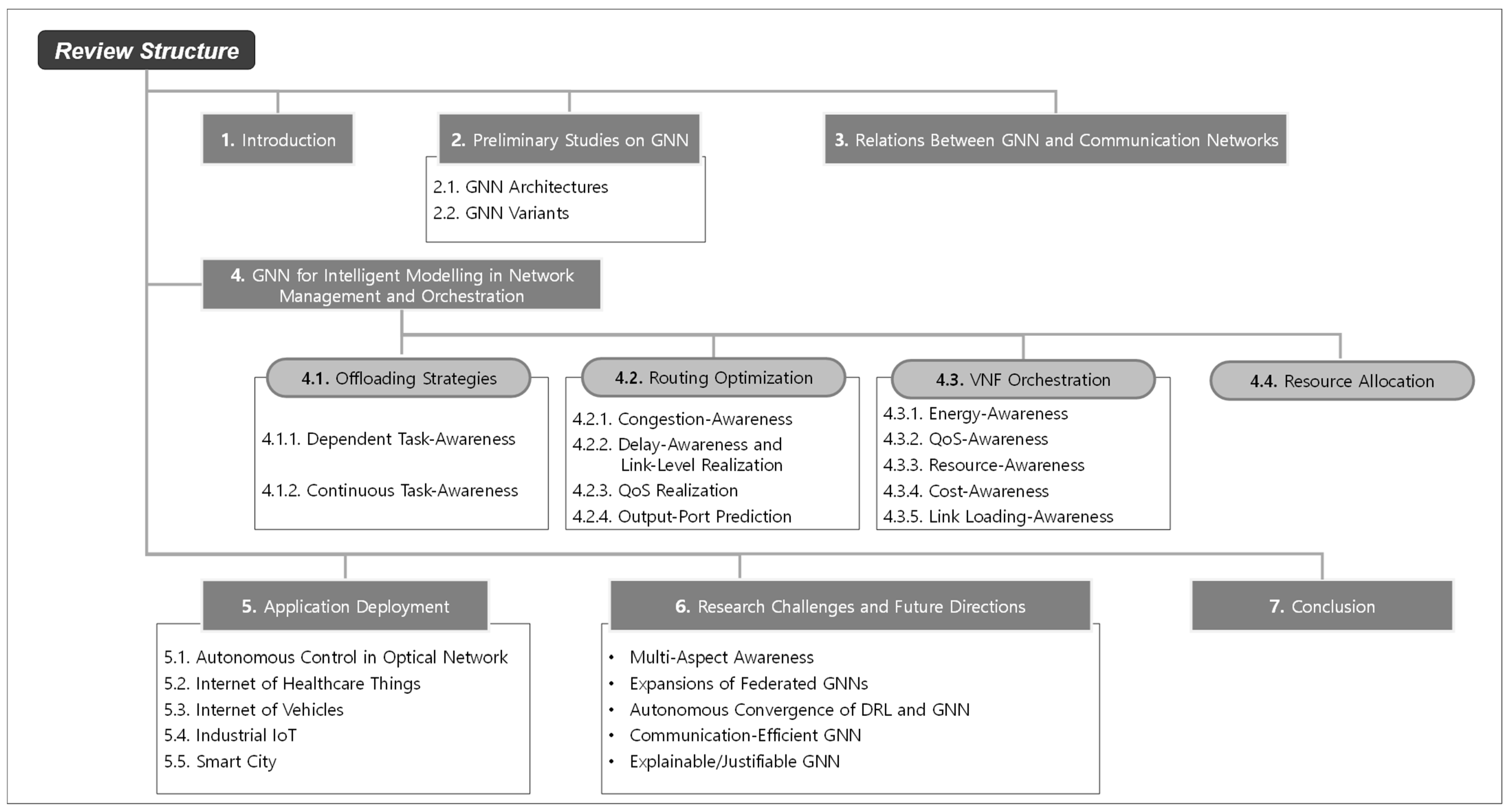
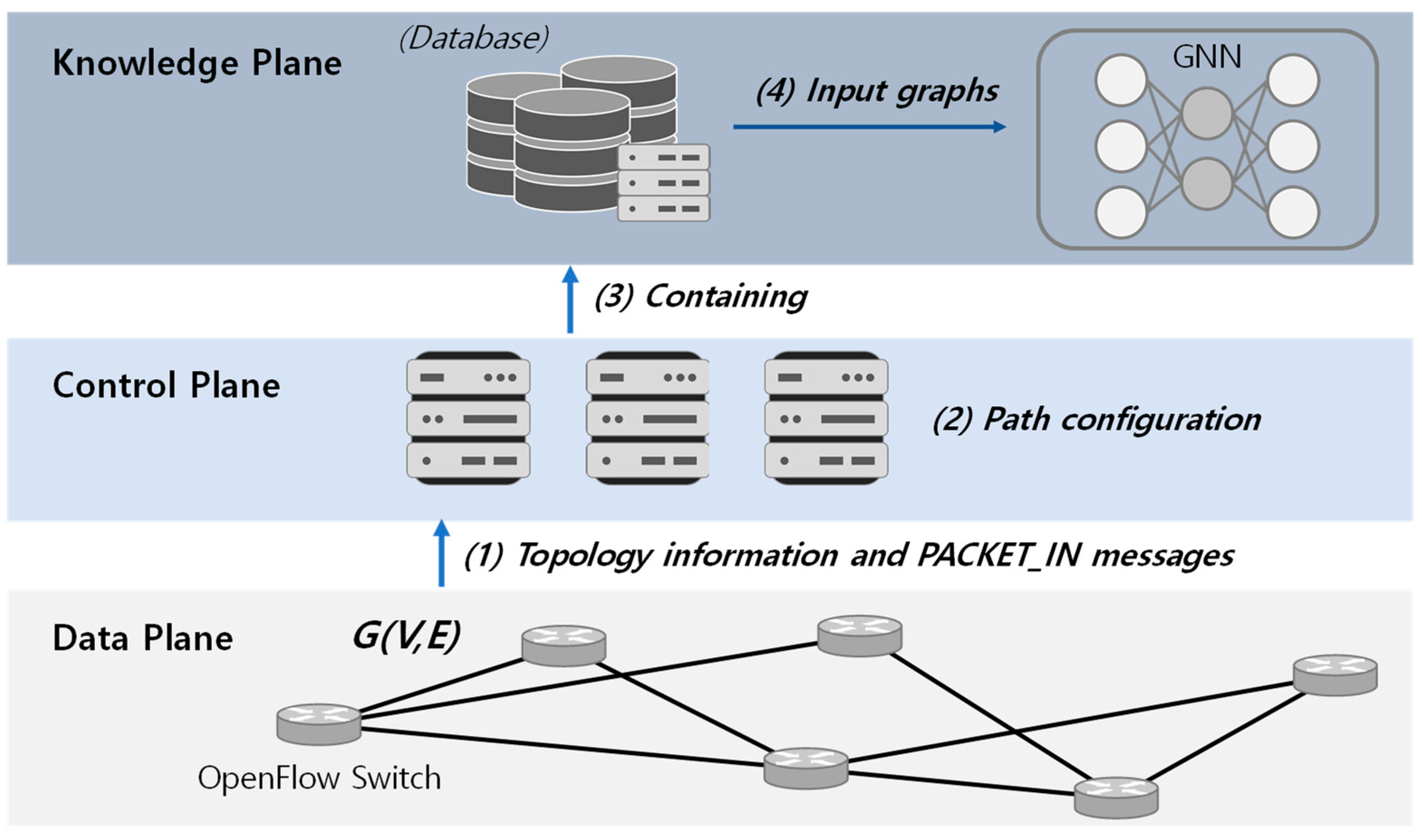
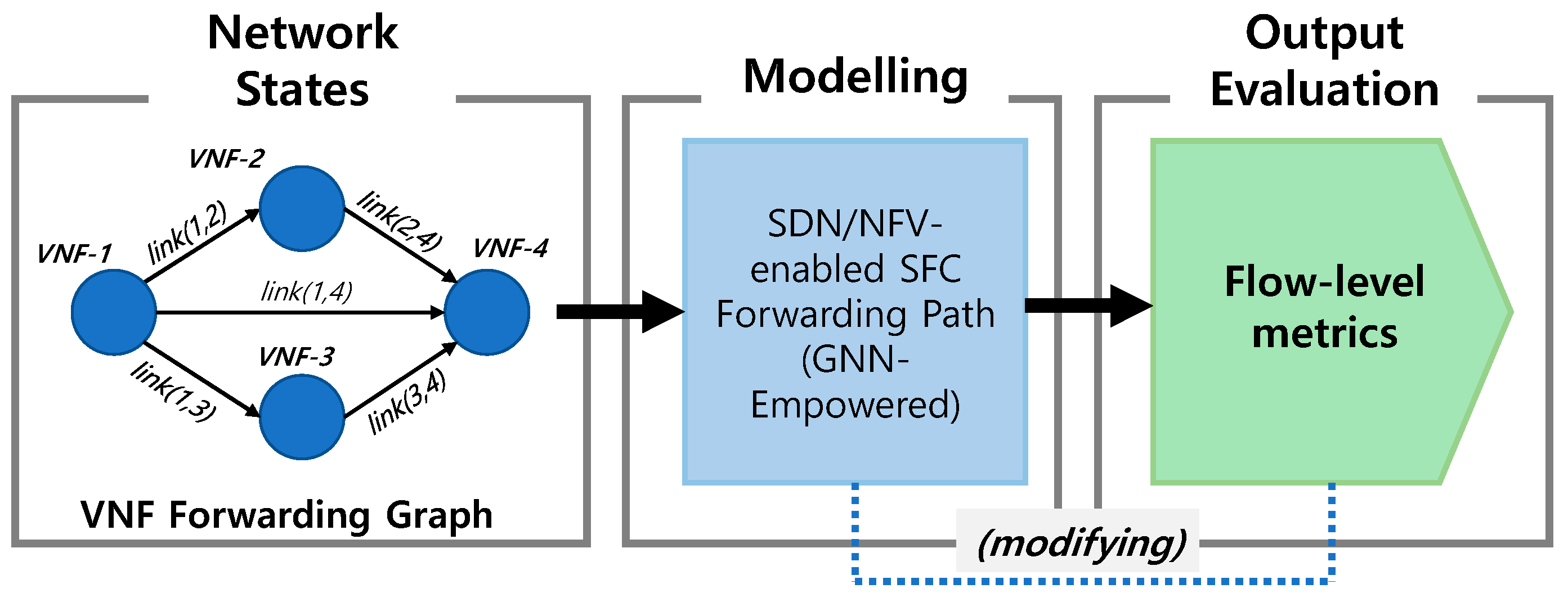
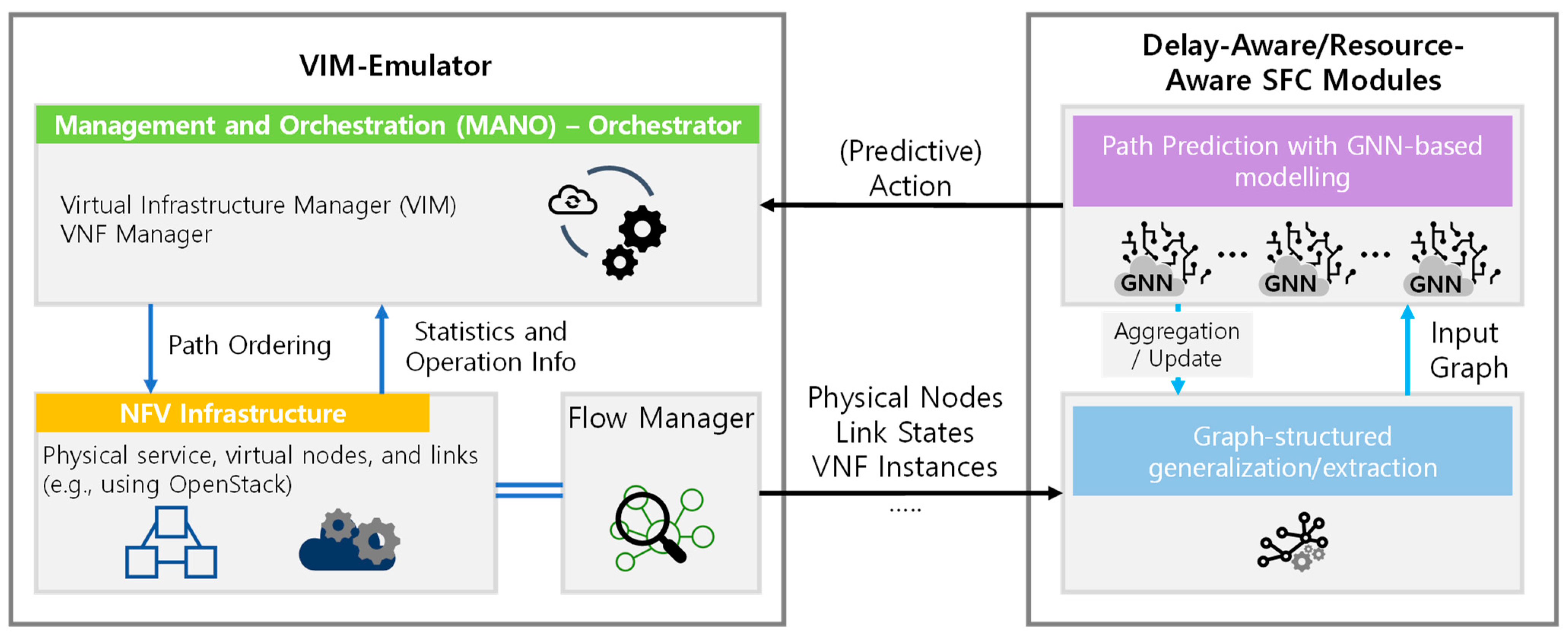
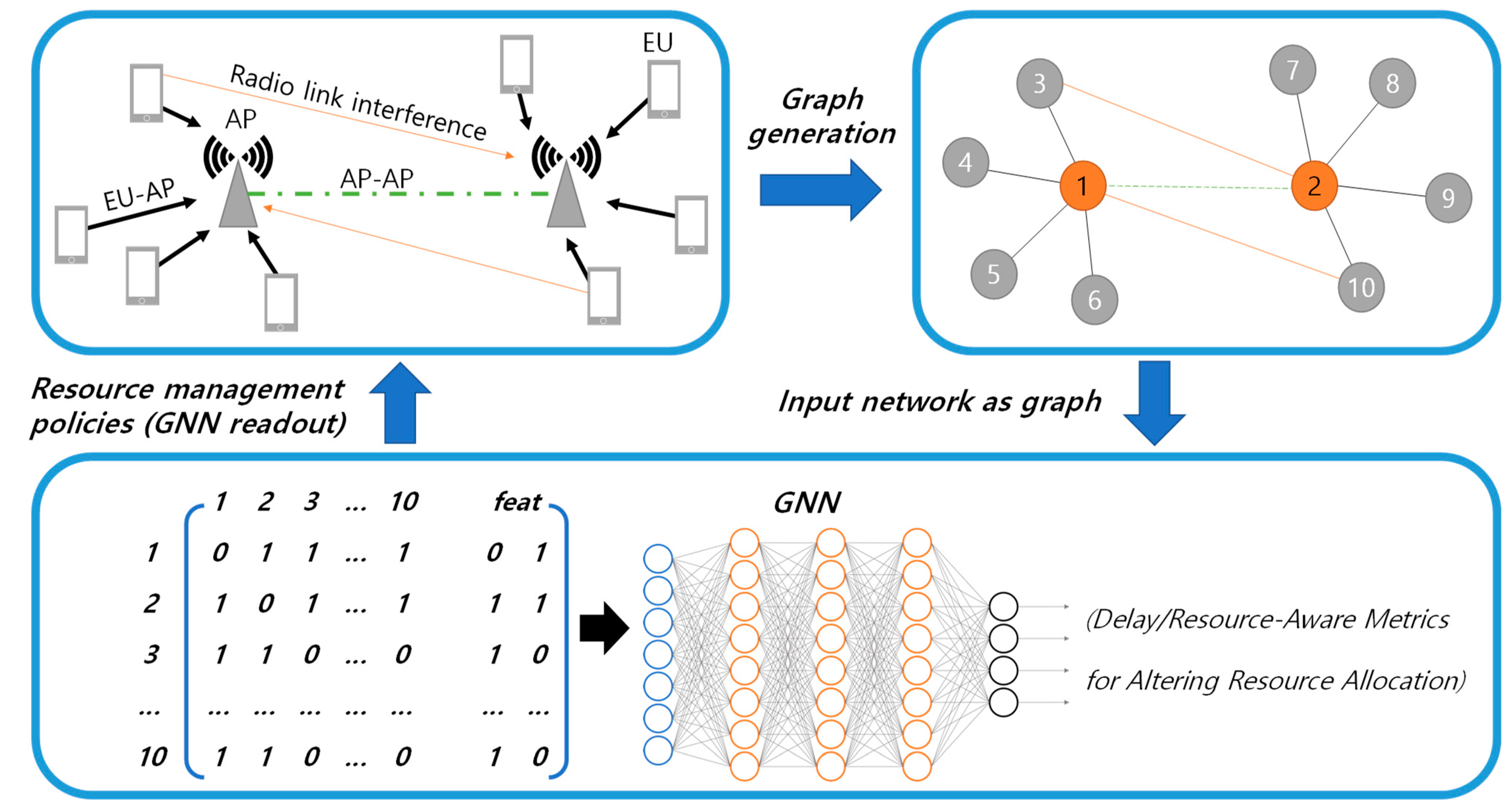
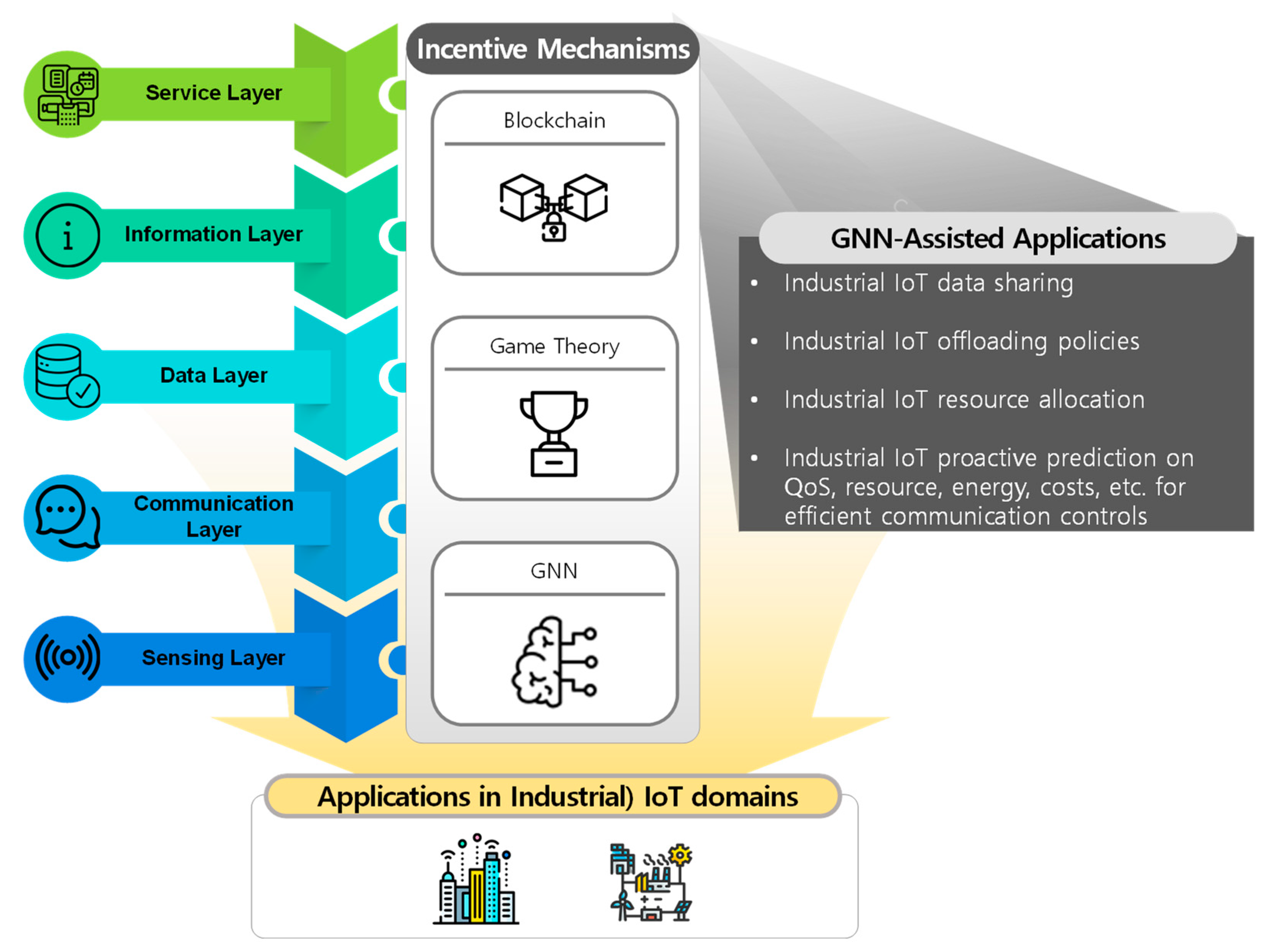
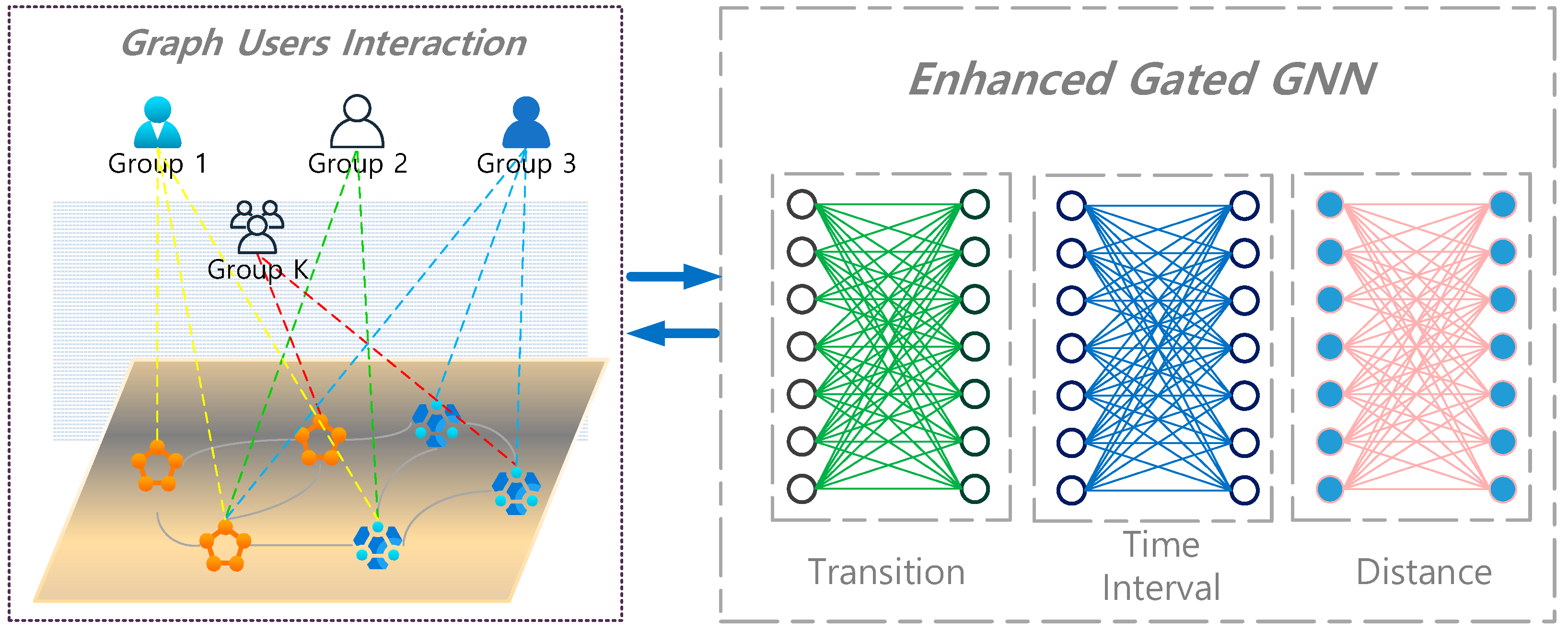
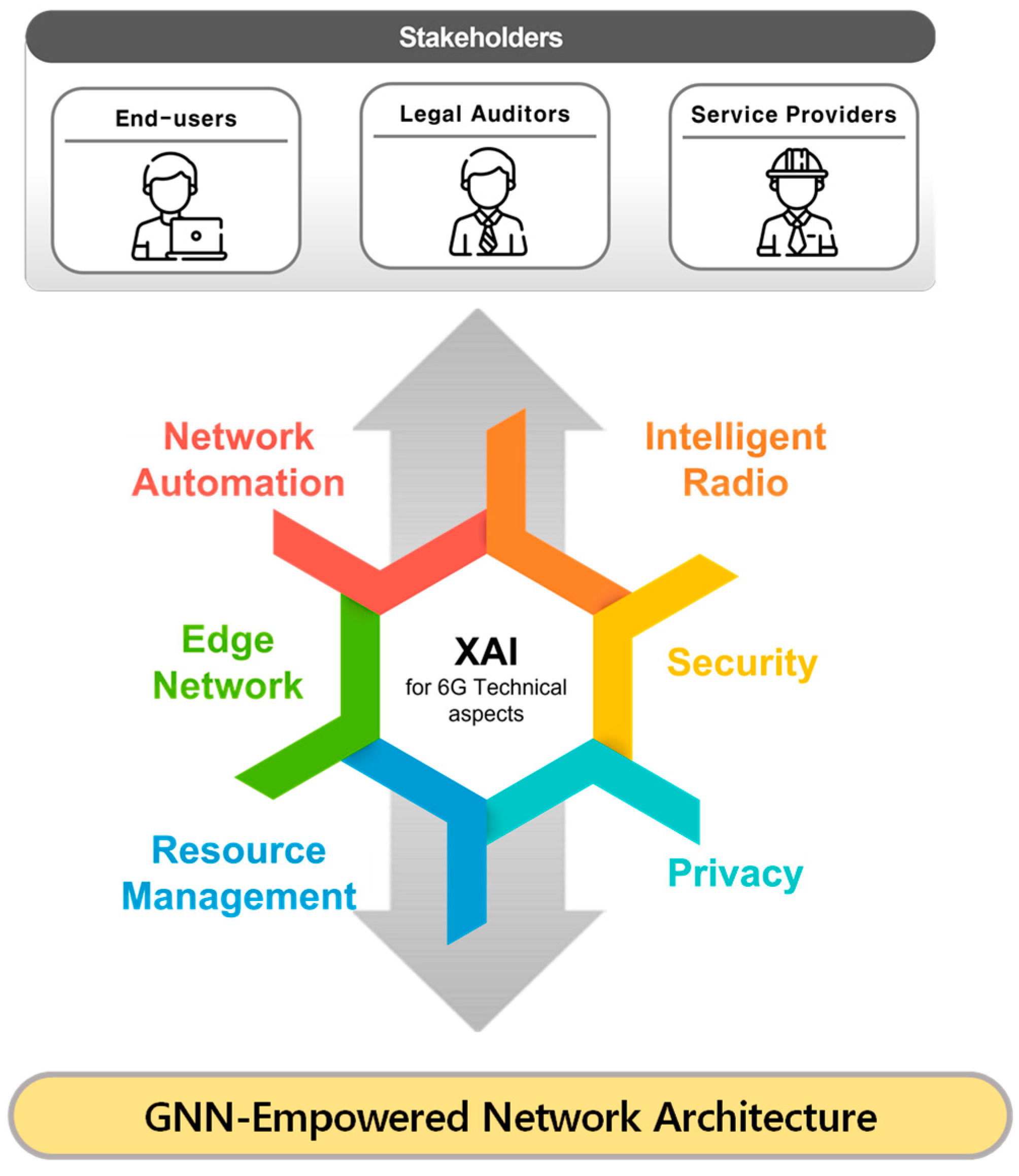
| Abbreviation | Description |
|---|---|
| CNN | Convolutional Neural Networks |
| DL | Deep Learning |
| DRL | Deep Reinforcement Learning |
| EC | Edge Computing |
| GAT | Graph Attention Networks |
| GCN | Graph Convolutional Networks |
| GNN | Graph Neural Networks |
| IoT | Internet of Things |
| MPNN | Message Passing Neural Networks |
| MDP | Markov Decision Process |
| MLP | Multi-Layer Perceptron |
| NFV | Network Functions Virtualization |
| QoS | Quality of Service |
| SFC | Service Function Chaining |
| SDN | Software-Defined Networking |
| VNF | Virtual Network Functions |
| Domains | Summary of Contributions | Ref. | Year |
|---|---|---|---|
| GNN Applications in Wireless Networks |
| [38] | 2021 |
| Potentials of GNN Towards Autonomous Optimization in Network Modelling |
| [39] | 2022 |
| Graph-based Deep Learning in Both Wired and Wireless Networks |
| [40] | 2022 |
| GNN-Based Approaches | Summary of Contributions | PETA | Ref. | Year | |
|---|---|---|---|---|---|
| 4.1. Offloading Strategies | 4.1.1. Dependent Task Awareness | GCN-based method was used for dependent task embedding as state features for actor–critic agents. GCN-based method was also applied to extract/generalize the graph structure of the application. | DRL (actor–critic), GCN, collaborative EC, directed acyclic graphs, MLP | [53] | 2022 |
| Optimal selection on access node, offloading node, and path via double GNNs to obtain the extracted features of service/network graphs and offer E2E multi-service offloading policy | Deep graph matching algorithm, GNN, collaborative EC | [54] | 2022 | ||
| 4.1.2. Continuous Task Awareness | A generalization and extraction capability concerning Euclidean space (from edge servers and task attributes) using GCN and fully connected layer to act as observable states for autonomous agent | GCN, directed acyclic graph, collaborative EC, soft actor–critic, long short-term memory | [55] | 2021 | |
| GNN-Based Approaches | Summary of Contributions | PETA | Ref. | Year | |
|---|---|---|---|---|---|
| 4.2. Routing Optimization | 4.2.1. Congestion awareness | Modified GAT to extract the graph-structured patterns in cell connectivity for intelligent congestion prediction | GAT, netlist graph, Kendall ranking coefficient | [59] | 2019 |
| Appointing GNN in the orient phase for predicting latency and loading metrics to assist decision-making on high/low congestion-aware routing | Network controller, GNN, interfere engine, route filter | [60] | 2021 | ||
| 4.2.2. Delay awareness and link-level realization | GNN as a function approximator to value the action of node selection in proposed agents (reward valuation of packet delivery and delay) | DRL (deep Q networks), Q-routing algorithm, GNN, SDN-enabled networks | [61] | 2021 | |
| Efficient DRL agent operation integrating with GNN architecture to set the source, destination, and link-level bandwidth allocation in SDN routing use case | DRL (deep Q networks), GNN, MPNN, SDN-enabled optical transport network | [62] | 2020 | ||
| Attention-weight link adjustment as actions to alter the wireless network routing states, which are executed on DRL and GNN (generalization capability) framework | DRL (deep deterministic policy gradient), GNN, wireless sensor network | [63] | 2021 | ||
| An autonomous GNN and DRL approach for SDN-enabled routing to consider optimizing end-to-end delays in various multi-path schemes, topologies, link failures, and traffic demands | DRL, GNN, SDN-enabled networks, multi-path routing network architecture | [64] | 2022 | ||
| A data/experience-driven routing algorithm to minimize link congestion using GNN-based policy system architecture with DRL | DRL, (iterative) GNN, MLP comparison | [65] | 2021 | ||
| Within SDN architecture, GNN is placed in the knowledge plane to associate with graph-structured network data through the controller by formulating to predict delay, configure timeout settings, and install flow rule entries. | GNN, SDN-enabled networks, MPNN, multi-path routing network architecture | [66] | 2022 | ||
| 4.2.3. QoS realization | A message-passing architecture was given to illustrate the procedures towards generalization capabilities, different dimensionality handling, and aggregation. Models on QoS metrics were formulated for assisting the routing strategies. | GNN, MPNN, recurrent neural networks, SDN-enabled architecture | [67] | 2020 | |
| An enhancement enabler towards future intelligent features and QoS-improved systems in terms of handling traffic model complexity, overlay routing, and scheduling | GNN, queuing theory comparison | [68] | 2022 | ||
| Learning the model proactively for preventing exceeding computation time during real-time operation and graph-based topology change handling | GNN, MLP, pointwise CNN, genetic algorithm comparison | [69] | 2020 | ||
| 4.2.4. Output-port prediction | GNN was used for node feature generation, which has later associated with artificial neural networks and attention mechanisms to train the prediction model for forwarding packets with shortest/optimal paths. | GNN, artificial feed-forward neural networks, attention mechanism, SDN | [70] | 2022 | |
| GNN-Based Approaches | Summary of Contributions | PETA | Ref. | Year | |
|---|---|---|---|---|---|
| 4.3. VNF Orchestration | 4.3.1. Energy awareness | (1) GCN for SFC-directed graph processing and (2) node representation for action selection (VNF deployment and virtual link mapping) in DRL-assisted approach | GCN, DRL (double deep Q networks), SFC, VNF | [71] | 2021 |
| 4.3.2. QoS awareness | To optimally instantiate the SFC path, GNN-based architecture was used to interact encoder and decoder (SFC environment) with the generalization of topology representation and prediction of each VNF deployment. | GNN, SFC (encoder-decoder), VNF | [72] | 2020 | |
| With SFC (encoder-decoder) extension from [72], reinforcement learning observed the states of decoder inputs, annotation, and adjacency matrix for feeding into GNN. The reward evaluated the delay of SFC path execution. | Reinforcement learning, GNN, SFC, VNF | [73] | 2020 | ||
| Digital twin for efficient end-to-end latency in multi-network slicing with GNN-based method by activating virtual representation and graph-structured slice/node information | GNN, digital twin, network slicing | [74] | 2022 | ||
| 4.3.3. Resource awareness | With edge cloud/network states, the GNN-based SFC path prediction model was used for efficient VNF deployment associated with the proposed resource-aware module | GNN, SFC, VNF, SDN/NFV-enabled networks | [75] | 2020 | |
| Asynchronous DRL for advancing GNN modelling in VNF resource prediction with policy weight adjustment | GNN, Asynchronous DRL (deep Q-learning), SFC, VNF, NFV-enabled networks | [76] | 2019 | ||
| The architecture of DeepOpt for interactively accessing the graph-structured information of the NFV environment to (1) assist autonomous agent training and (2) translate the agent policy for efficient VNF deployment | GNN, DRL, VNF, NFV-enabled networks | [77] | 2021 | ||
| 4.3.4. Cost awareness | Optimized VNF policy by GNN approach and generalization for VNF management to provide efficient joint costs of energy, placement, forwarding, allocation, etc. | GNN, VNF, SDN/NFV-enabled networks | [78] | 2020 | |
| 4.3.5. Link Loading awareness | An optimization approach to SFC design and mapping with objectives of minimizing the link load factor | virtual network embedding, NFV-enabled networks, integer linear programming | [79] | 2022 | |
| GNN-Based Approaches | Summary of Contributions | PETA | Ref. | Year |
|---|---|---|---|---|
| 4.4. Resource Allocation | GNN approach to advance the state representation for DRL agent in resource optimization of VNF placement and routing | SDN and NFV-enabled IoT networks, GNN, DRL, VNF forwarding graph, directed acyclic graph | [80] | 2022 |
| Optimizing the training costs, computation, and generalization via an efficient GNN-based resource management scheme | Radio resource management, wireless networks, GNN, MPNN | [81] | 2020 | |
| Consideration of allocation policies in wireless networks with an efficient scheme using random edge GNN for enhanced large-scale systems | Wireless resource allocation, GNN | [82] | 2020 |
| GNN-Based Application Deployment | Summary of Contributions | Ref. | Year |
|---|---|---|---|
| 5.1. Autonomous Control in Optical Networks | GNN-based modelling for latency estimation and network reconfiguration policy | [83] | 2022 |
| 5.2. Internet of Healthcare Things | The applicability of applied GNN to enable graph-structured data in malware detection, monitoring system, data management, and anomaly detection | [84] | 2021 |
| [85] | 2020 | ||
| 5.3. Internet of Vehicles | GNN-driven traffic forecasting (Chebyshev Networks, GCN, GAT) and trajectory clustering for intelligent vehicle systems | [86] | 2021 |
| [87] | 2021 | ||
| 5.4. Industrial IoT | GNN-driven anomaly detection (point, contextual, and collective) in three case studies including smart transportation, smart factory, and smart energy | [88] | 2022 |
| 5.5 Smart City | Spatial-temporal attention GCN for vehicle prediction, and federated deep learning with graph representation for traffic flow prediction in urban application services | [89] | 2022 |
| [90] | 2022 | ||
| [91] | 2022 |
| Domains | Suggestions on Emerging Technologies | Deployable Environments | Ref. |
|---|---|---|---|
| Multi-Aspect Awareness | (1) Multi-objective awareness with attention mechanisms, (2) weighted sum modelling, and (3) proactive GNN predictions | Next-generation optimization (e.g., SFC orchestration), SDN/NFV-enabled networks | [98,99] |
| Expansions of Federated GNNs | (1) (Edge) federated learning, (2) distributed GNN, and (3) privacy-restricted regulations | High privacy-sensitive data, differential privacy | [100,101,102,103] |
| Autonomous Convergence of DRL and GNN | (1) DRL, (2) MDP, and (3) GNN on state representation, action selection, or reward valuation mechanism | Zero-touch network and service management, next-generation network automation systems | [5,104] |
| Communication-Efficient GNN | (1) GraphSAGE and (2) mission-critical slicing prioritization | Large-scale network graphs, real-time services | [32,105,106] |
| Explainable/Justifiable GNN | (1) Justification module, (2) GNN-empowered architecture, and (3) explainable artificial intelligence (XAI) | Edge intelligence, network automation, intelligent radio, enhanced security | [107,108] |
Publisher’s Note: MDPI stays neutral with regard to jurisdictional claims in published maps and institutional affiliations. |
© 2022 by the authors. Licensee MDPI, Basel, Switzerland. This article is an open access article distributed under the terms and conditions of the Creative Commons Attribution (CC BY) license (https://creativecommons.org/licenses/by/4.0/).
Share and Cite
Tam, P.; Song, I.; Kang, S.; Ros, S.; Kim, S. Graph Neural Networks for Intelligent Modelling in Network Management and Orchestration: A Survey on Communications. Electronics 2022, 11, 3371. https://doi.org/10.3390/electronics11203371
Tam P, Song I, Kang S, Ros S, Kim S. Graph Neural Networks for Intelligent Modelling in Network Management and Orchestration: A Survey on Communications. Electronics. 2022; 11(20):3371. https://doi.org/10.3390/electronics11203371
Chicago/Turabian StyleTam, Prohim, Inseok Song, Seungwoo Kang, Seyha Ros, and Seokhoon Kim. 2022. "Graph Neural Networks for Intelligent Modelling in Network Management and Orchestration: A Survey on Communications" Electronics 11, no. 20: 3371. https://doi.org/10.3390/electronics11203371
APA StyleTam, P., Song, I., Kang, S., Ros, S., & Kim, S. (2022). Graph Neural Networks for Intelligent Modelling in Network Management and Orchestration: A Survey on Communications. Electronics, 11(20), 3371. https://doi.org/10.3390/electronics11203371








